In this Article
Toggle
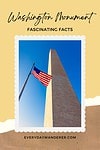
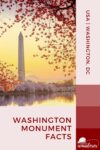
As an enduring symbol of American democracy, the Washington Monument has stood tall in the nation’s capital for generations. Discover fascinating Washington Monument facts that transcend time and celebrate the spirit of this iconic structure.
Although he lived more than 220 years ago, practically every American from kindergarten on knows that George Washington was:
- a plantation owner at Mount Vernon in northern Virginia,
- a victorious general who led a ragtag group of patriots to victory over England,
- a Founding Father, and
- the first president of the United States.
But do you know these facts about the tallest building in Washington, DC, honoring an American icon, our first president?
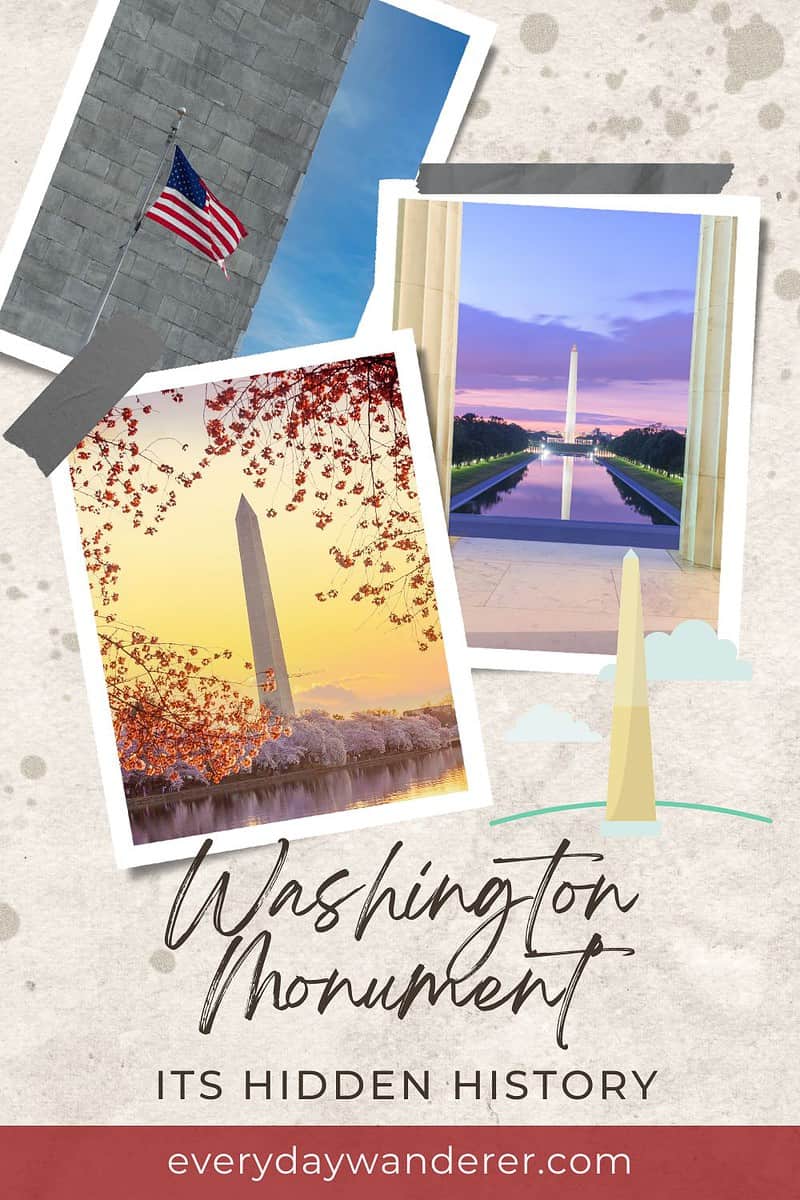
To help offset the costs of running EverydayWanderer.com, you’ll find affiliate links lightly sprinkled throughout the site. If you choose to make a purchase via one of these links, there’s no additional cost to you, but I’ll earn a teeny tiny commission. You can read all of the legal blah blah blah (as my little niece says) on the full disclosure page.
1. The Current Design Was Not the Original Plan for the Washington Monument
After the American Revolution, discussions began about creating a monument to honor General Washington. In fact, Pierre L’Enfant’s original design for Washington, DC, included a prominent space for the capital city’s namesake between the White House and the US Capitol.
When George Washington died in 1799, Congress authorized the construction of a memorial honoring POTUS #1. But bickering over what type of landmark would appropriately honor him and a lack of funding stalled the project. And, when the Jeffersonian Republicans gained power at the turn of the century, they promptly voted to cancel the project (more on that later).
Fast forward a few decades to 1833. The Washington National Monument Society was established and successfully raised a good chunk of change to fund the memorial. The society held a contest to select a designer for the Washington Monument. An architect named Robert Mills from South Carolina won, but his design differs from what you see today when you visit Washington, DC.
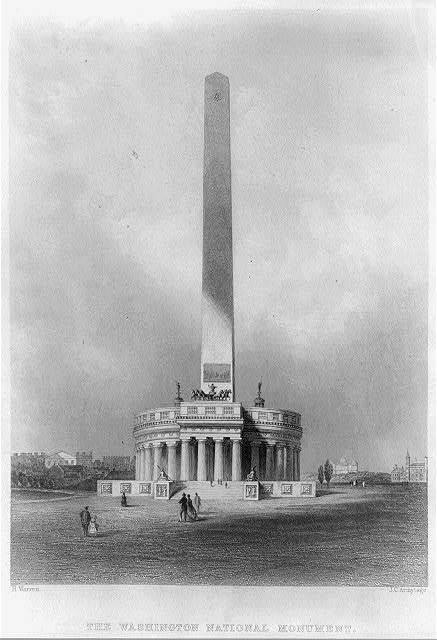
Mills’s original design was much more grandiose. It featured an obelisk similar to the one you know and love today but standing on a base of thirty 100-foot columns. Each column, resembling the Roman Pantheon, would dedicate itself to one of the 30 signers of the Declaration of Independence. The monument incorporated George Washington as a statue standing in a chariot pulled by six horses. (That takes the iconic image of General Washington on horseback to a whole new level, right?)
2. The Original Monument Design was $1 Million in 1848
Although the Washington National Monument Society picked Mills’s proposal as the winner of its design competition, critics felt it was over the top and too expensive. After all, $1 million in the 1840s is about $32.5 million in today’s dollars.
So, a simplified version of Mills’s design featuring just the Egyptian obelisk began in 1848. However, when the monument officially opened to the public in 1888, it had incurred a cost of $1.4 million. (Good thing they stopped there!)
While $32.5 million is a lot of money, the Dwight D. Eisenhower Memorial, one of the newest in the nation’s capital, totaled about $150 million. And the World War II Memorial cost $175 million to construct.
3. Three Future Presidents Attended the Cornerstone-Laying Ceremony on July 4, 1848
The cornerstone for his monument was laid nearly 50 years after Washington’s death. The stone was embedded with a box that included a portrait of George Washington, a Bible, a city map, and a copy of the United States Constitution. It was inscribed with these words, “4th July, 1848. This Corner-Stone Laid of a Monument, by the People of the United States, to the Memory of George Washington.”
More than 20,000 people covered the grassy expanse of the National Mall on America’s birthday to participate in the event. But a little known Washington Monument fact is that three future presidents were in attendance:
- James Buchanan, POTUS #15
- Abraham Lincoln, POTUS #16
- Andrew Johnson, POTUS #17
4. It Took Years (And Years) to Finish the Washington Monument
After the cornerstone was laid on Independence Day in 1848, it took another four decades to complete the nation’s first Washington, DC, monument.

The first roadblock was in 1858 when funding ran out and the obelisk had reached only a quarter of its planned height. A few years later, the Civil War broke out. One of the most surprising facts about the Washington Monument is that Union soldiers used the grassy area surrounding the partially completed monument to feed cattle to supply troops during America’s bloodiest conflict.
That brings a whole new meaning to appropriating public land!
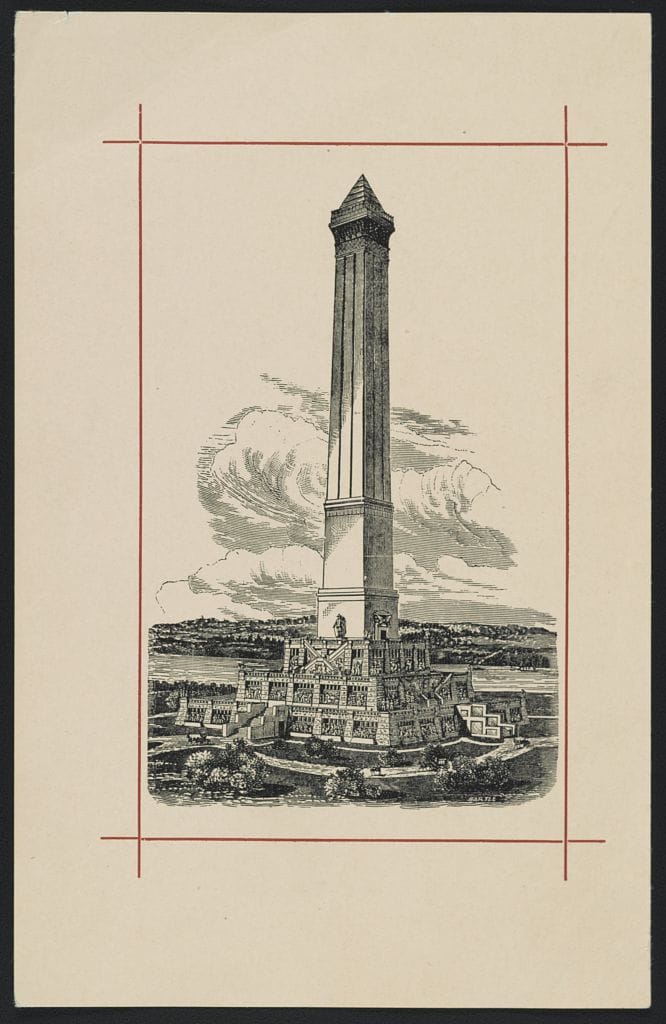
As America celebrated her 100th birthday, a desire to complete the paused project honoring her first president grew. Many folks thought the lone obelisk without its colonnade resembled a lone stalk of asparagus and should be more grand and impressive to honor a man like George Washington. But, as you know, a single stone structure was ultimately completed after a few modifications were made to ensure the obelisk had classic Egyptian proportions.
With a design decided once and for all, construction resumed in 1879 under the leadership of Lt. Col. Lincoln Casey and the Corps of Engineers. The monument’s exterior was completed in 1884, and a formal dedication was held on the eve of what would have been Washington’s 153rd birthday on February 21, 1885.
5. And It STILL Took Years Before the Monument Was Open to the Public
After its dedication in 1885, more work had to be done before opening the monument to the public. Tasks included the completion of an iron staircase inside the monument to allow folks to visit the observation deck and, ultimately, a public elevator.
At long last, nearly 90 years after Washington’s death, the monument honoring the war hero and first president opened to the public on October 9, 1888.
Pro Tip: From the White House to George Washington University, learn more about the nation’s first president in this interactive Washington, DC, scavenger hunt.
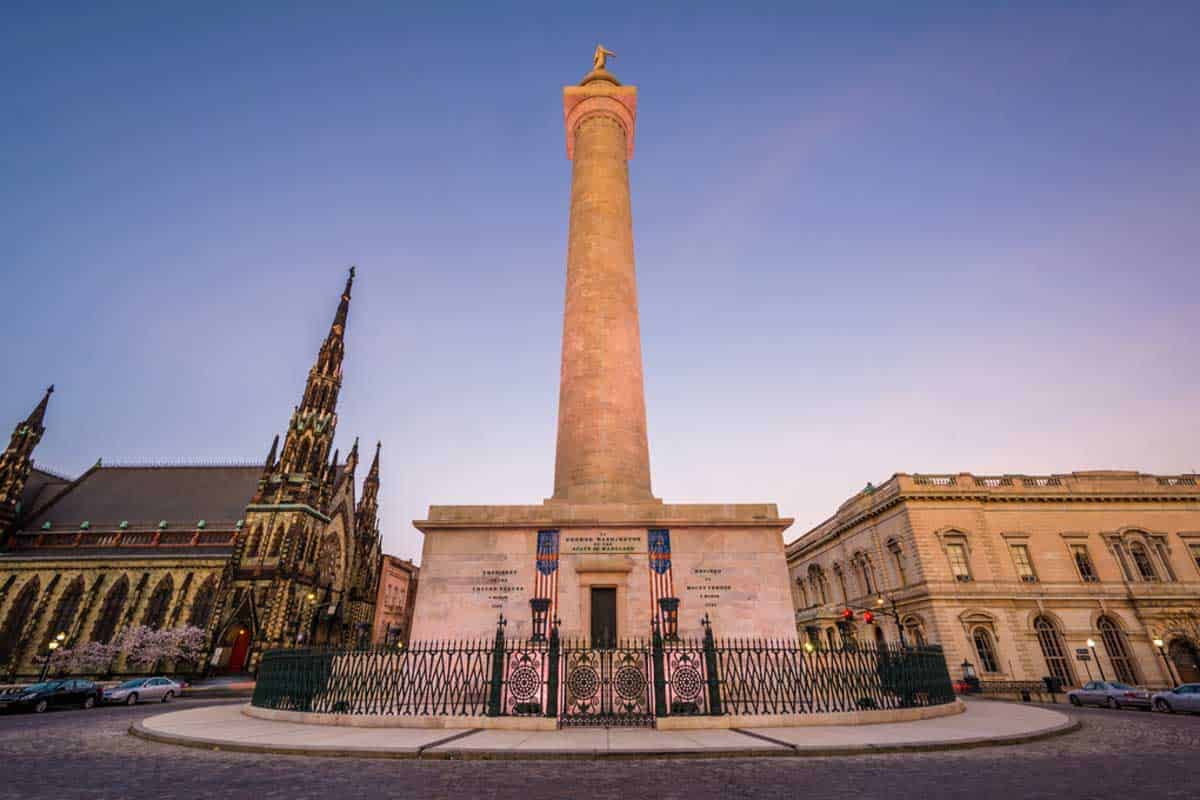
6. The Washington Monument on the National Mall is Not the First Monument Honoring the First US President
Although the Washington Monument on the National Mall is the most recognized monument honoring America’s first president, it’s not the first monument to do so.
While the powers that be in DC spent decades arguing, architect Robert Mills quietly constructed his own Washington monument. On land donated by Col. John Eager Howard in Baltimore, about 40 miles northeast of the National Mall, Mills finished a nearly 200-foot Doric column with panoramic views from the top in 1829.
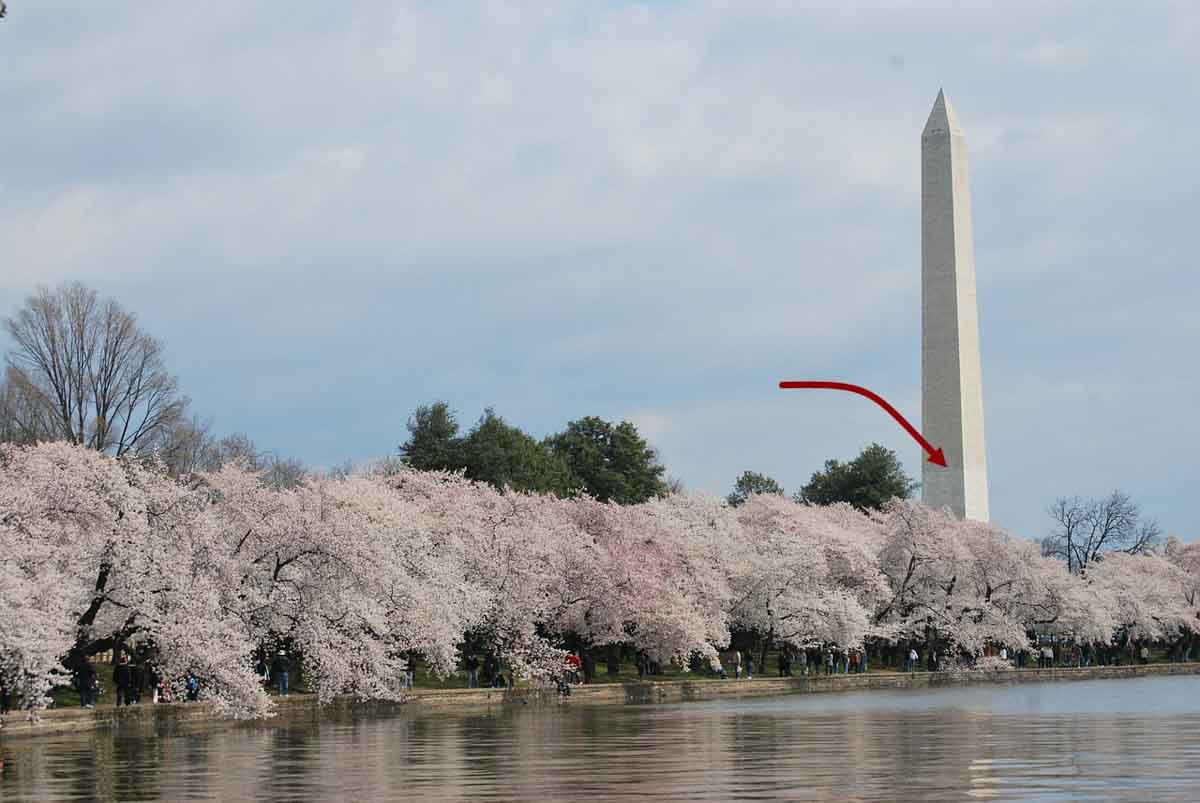
7. The Washington Monument is Two Different Shades of White
When the Army Corps of Engineers resumed construction after more than two decades, the Maryland quarry’s original stone was no longer available. Builders used stone from a Massachusetts quarry instead, but after adding a few vertical feet, they were displeased with its look. So, the monument was completed with stones from another quarry in Maryland.
At the time, the new stone looked like a decent match. However, environmental elements aged the granite differently, and you’ll notice a visible color difference in the upper two-thirds of the obelisk.
Pro Tip: One of the most remarkable ways to see the monuments and memorials of Washington, DC, is via a guided night tour.
8. The Top of the Washington Monument Weighs More Than a Ton and is Capped with This Surprising Metal
At some point between Mills’s original design for the Washington Monument and the version completed by the Army Corps of Engineers, the tip of the obelisk evolved from a flat top to a pointed capstone. The pyramid-shaped stone at the top of the monument weighs 3,300 pounds and was pulled through one of the observation floor windows and hoisted into place.
But the very tip of the capstone is an approximately nine-inch aluminum piece. You read that correctly — not gold, silver, bronze, or copper. Aluminum. While thicker than the aluminum foil used to wrap up and smoke ribs for a barbeque, that’s a lot of Reynolds Wrap!
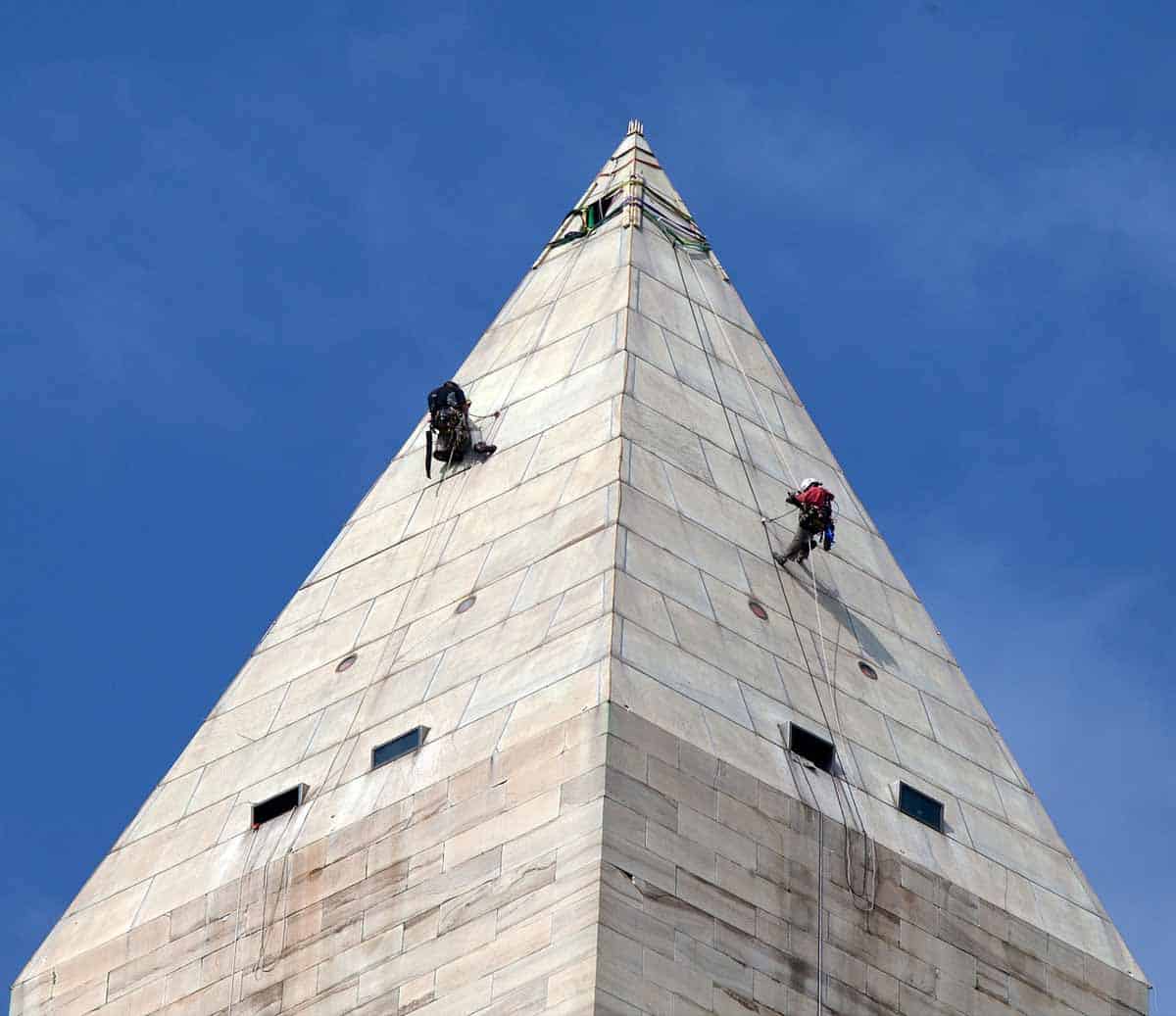
Legend has it that aluminum was more precious than silver at the time and predominantly used for jewelry. Still, several sources I reviewed suggested that the two metals were equally priced at $1 per ounce. While aluminum is an everyday metal in our 21st-century lives, the monument topper was the largest piece of aluminum in its day (less than a foot tall). And, before it capped the Washington Monument, it was displayed at Tiffany’s jewelry store in New York.
The more likely reason behind the unusual metal choice was that aluminum was believed to be the best deterrent for lightning strikes. While that may have been the conventional wisdom of engineers in the 1880s, unfortunately, aluminum is a conductor of electricity.
When the engineers returned to the top of the Washington Monument six months after placing the aluminum pyramid at the top, they discovered that it had not only been struck by lightning but had melted about 3/8ths of an inch. So, two aluminum lightning rods were added to the tip of the landmark, and the original aluminum piece became nothing more than a unique decoration.
Each of the four angled sides of the pyramid includes inscriptions recognizing the men who designed and built the monument and marking milestones during the landmark’s construction. On the east face, positioned to face the rising sun each morning, are the Latin words “Laus Deo,” which means “Praise be to God.”
So, it’s no wonder the Washington Monument plays a vital role in Dan Brown’s thriller, The Lost Symbol.
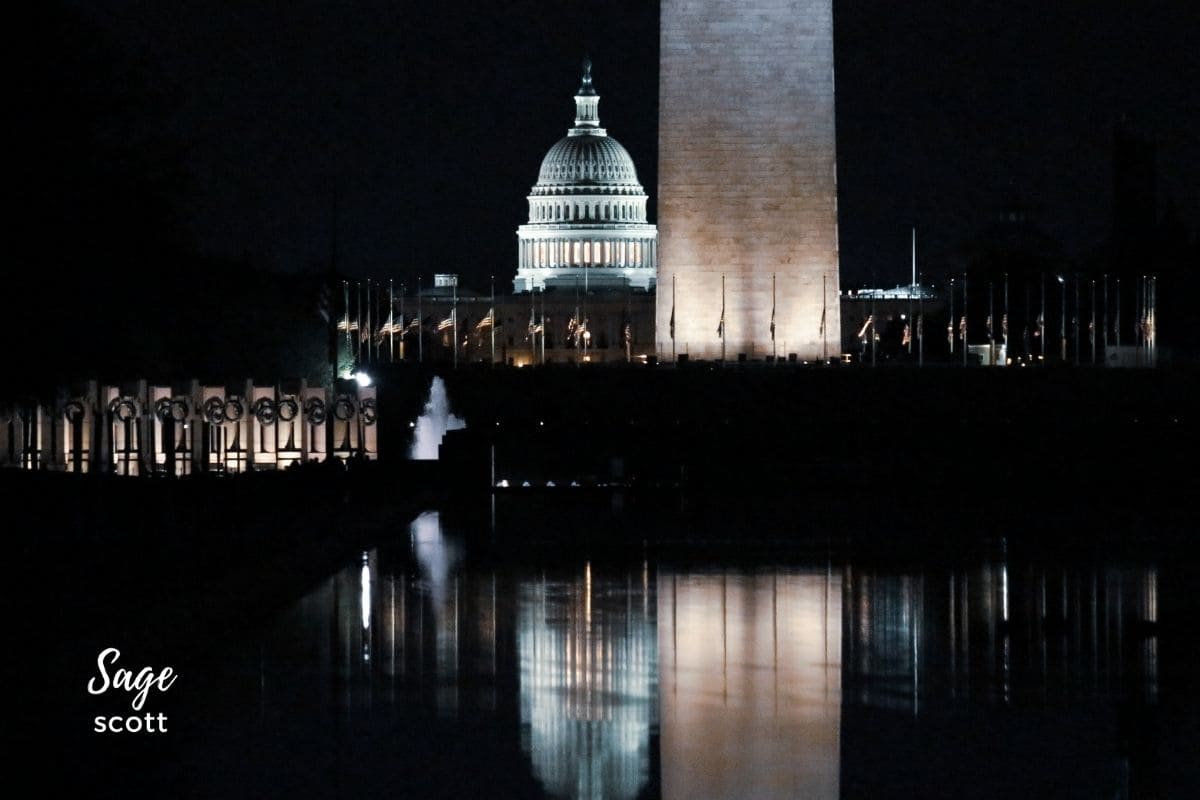
9. When Completed, the Washington Monument Was the World's Tallest Man-Made Structure
(And its size still matters today)
Although the obelisk originally designed by Mills was 600 feet tall, the Washington Monument ultimately built stands at 555 feet, 5-⅛ inches tall. When the exterior was completed in 1884, it was the tallest structure in the world.
But it only held the top spot for a short time. The Eiffel Tower knocked it to second place when it opened as the 1889 World’s Fair entrance in Paris. But the Washington Monument remains the world’s tallest predominantly stone structure and the world’s tallest obelisk. And its size will always matter in Washington, DC, because no building in DC is allowed to be taller than the Washington Monument.
Pro Tip: It’s easy to walk a marathon each day that you explore Washington, DC. Give your feet a break by touring the monuments by bike.

10. The Washington Monument Doesn't Just Honor America's First President, It Unites the Nation
As you stroll the monument grounds, you’ll notice 50 American flags encircling the obelisk’s base.
Set inside the east and west interior walls are nearly 200 commemorative stones. Although the United States didn’t have 50 states until 1959, when Hawaii joined the union, all are represented by a memorial stone along with cities, foreign countries, organizations, and individuals.
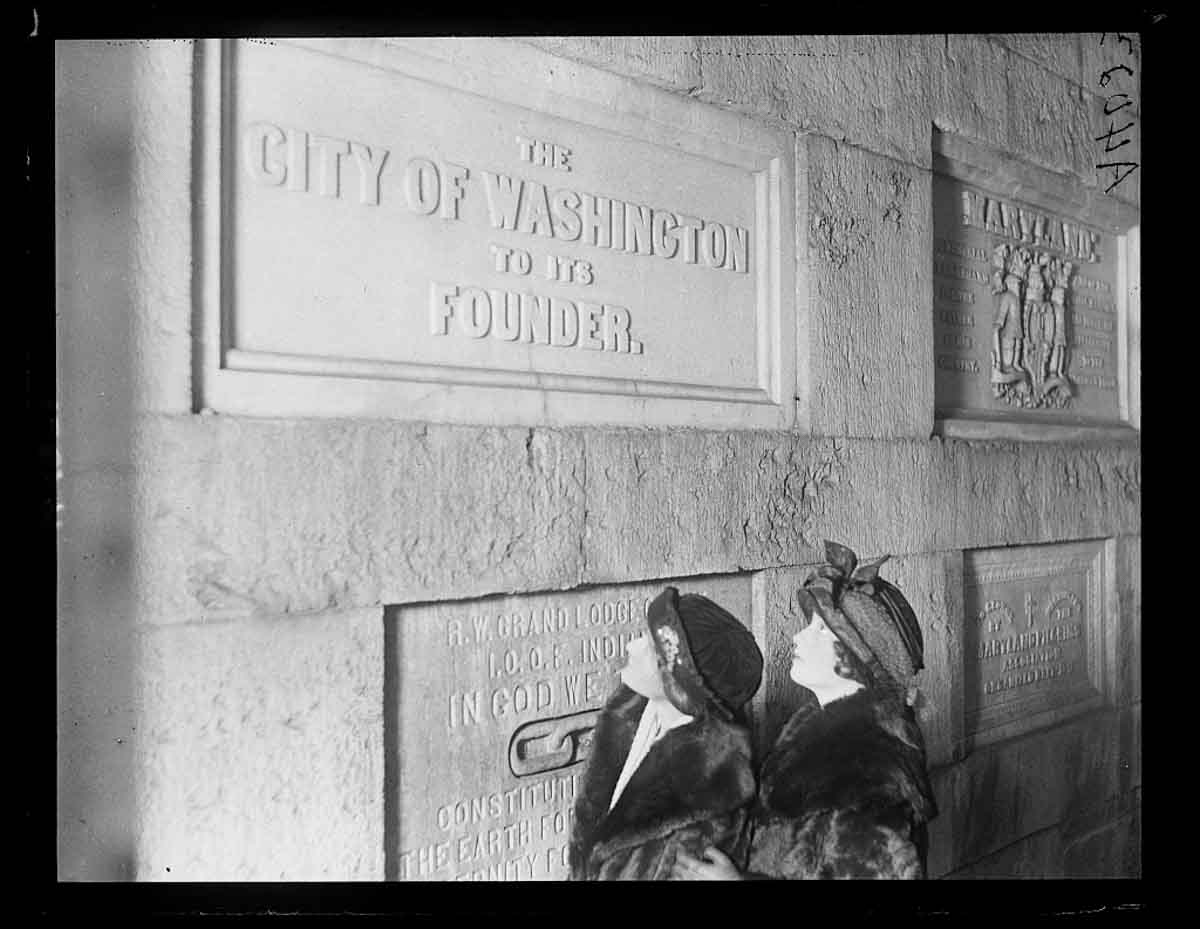
The memorial stones range in size from small squares a little more than a foot wide to large rectangles that measure six feet by eight feet. They are carved out of a variety of stones, like granite, white marble, limestone, and sandstone, and are accented with materials as unique and varied as each presenting destination or organization. There is jade from Alaska, petrified wood from Arizona, copper from Michigan, and pipestone from Minnesota.
Since the stairs inside the Washington Monument were closed in 1976, the only way to see the memorial stones is via an occasional ranger-led tour. Unfortunately, even those were discontinued after an earthquake impacted the building in 2011. When I visited the District of Columbia in March 2021, a U.S. National Park Service ranger told me that lead had been discovered in the stairwell paint, making it even less likely they would resume any time soon.
Fun Fact: The state of Utah has two memorial stones inside the Washington Monument. It contributed one stone as a US territory using the pre-territorial name of Deseret and another stone after being admitted as the 45th state on January 4, 1896.
11. The Washington Monument is the Only Presidential Monument in Washington That Requires a Ticket
This Washington Monument fact requires you to plan ahead when you visit Washington, DC.
Since the stairs are permanently closed to visitors, the only way to ascend to the top of the Washington Monument is by elevator. There is no cost to ride the elevator, but only a set number of tickets are available daily.
To ensure you can gaze out one of the eight observation windows and see up to 30 miles on a clear day, you may want to splurge the $1.50 per ticket to reserve a spot on your preferred day.
Whether you reserve your ticket in advance or take your chances, be glad that the electric elevator ride has improved over the years. When the original steam-driven elevator was installed, it took about ten minutes to climb the landmark. The contraption was considered so dangerous that only men were allowed to ride it. (Yes, women and children had to climb all 897 stairs. How gallant!)
12. A 5.8-Magnitude Earthquake Damaged the Washington Monument in 2011
When I think of earthquakes, I think of California. And I don’t expect much damage when I think of a 5.8 magnitude in California. But that’s not how things worked out for the Washington Monument in August 2011.
The quake damaged the elevator, broke off stones (hopefully none of those memorial ones), and opened cracks in the monument that were substantial enough for light to shine through. Repairs cost approximately $15 million, but billionaire philanthropist David M. Rubenstein of Bethesda, Maryland, donated half the funds.
Other Facts About the Washington Monument
Additional facts and figures about the Washington Monument in Washington, DC.
Where is the Washington Monument?
The Washington Monument is located on the National Mall in Washington, DC. It’s directly south of the White House and directly east of the Lincoln Memorial.
Who Does the Washington Monument Honor?
The Washington Monument honors General George Washington, a Revolutionary War hero, Founding Father, and the United States’ first president.
How Many Flags are Around the Washington Monument?
There are 50 American flags encircling the Washington Monument, one for each state in the Union.
How Tall is the Washington Monument?
The Washington Monument is 555 feet, 5-1/8 inches tall. When it was completed in 1884, the monument was the tallest structure in the world.
When was the Washington Monument Completed?
The Washington Monument was completed in 1884, dedicated in 1885, and opened to the public in 1888. It took approximately 40 years to complete the Washington Monument.
Who Designed the Washington Monument?
The monument was originally designed by Robert Mills, an architect from South Carolina who won a design contest held by the Washington National Monument Society in 1833. While chosen as the winning design, Mills’s original design was deemed too grandiose, and a scaled-back version was approved.
After construction was paused during the Civil War, architect Henry Searle proposed an updated design for the Washington Monument that resulted in the single obelisk you see today.
Who Built the Washington Monument?
From the placement of the cornerstone in 1848 to its grand opening to the public in 1888, it took 40 years to complete the Washington Monument. After several events stalled its progress, Thomas Casey and the US Army Corps of Engineers ultimately completed the Washington Monument.
Was the Washington Monument Built by Slaves?
While several historic buildings — like the White House and the US Capitol Building — were built by enslaved people, the facts surrounding the Washington Monument are a little more hazy.
While there doesn’t appear to be any evidence that enslaved people constructed the obelisk, slave labor was commonly employed at Maryland quarries used to source the monument’s stone blocks.
What is the Washington Monument Made of?
The Washington Monument is constructed of blocks of marble, blue gneiss, and granite.
Why is the Washington Monument Two Colors?
When construction of the Washington Monument began after a 20-year pause, stone blocks from the original quarry in Maryland were no longer available. Stones sourced from a new quarry appeared to match, but the materials have aged differently. Look for a visible difference in color about one-third of the way up the structure.
Can You Go Inside the Washington Monument?
Yes, but a limited number of people can visit per day, and a ticket is required.
Can You Go Up the Washington Monument?
Yes, but a ticket is required, and space is limited.
How Many Steps are in the Washington Monument?
There are just under 900 steps inside the Washington Monument. However, the stairs inside the Washington Monument have been closed to visitors since the 1970s.
Practical Information for Visiting the Washington Monument
What's the Address of the Washington Monument?
The Washington Monument is located at 2 15th St NW, Washington, DC.
When is the Washington Monument Open?
The Washington Monument is open daily from 9:00 am to 5:00 pm except on Christmas Day (December 25th).
Is There a Cost to Visit the Washington Monument?
There is no cost to visit or ascend the Washington Monument, but an entry ticket is required, and a limited number of tickets are available each day.
How to Get Washington Monument Tickets
Information about tickets to the Washington Monument (including advanced ticket reservations) is available on the National Park Service website.
What is the Best Place to Park Near the Washington Monument?
While public transportation is the most convenient way to visit the Washington Monument, limited public parking is available at the Paddle Boat Parking Lot along Maine Ave. SW, and along Ohio Drive, SW, between the Lincoln and Thomas Jefferson Memorials.
Have You Visited the Washington Monument in Washington, DC?
What did you like most about your visit to the Washington Monument? Did you get to visit the observation deck 500 feet above the nation’s capital? Any additional Washington Monument facts to pass along? Share your experiences in the comments section below.
Looking for more information to plan your Washington DC vacation? Check out my additional recommendations to help you plan your trip to Washington, DC, including what to see and do in Washington DC, the best places to stay in Washington DC, where to eat in Washington DC, and more!
Ready to Go?
Use These Helpful Links to Book Your Trip!
- Find low fares with airfarewatchdog and Skyscanner
- Book your plane ticket with Expedia or Kayak
- Or take the scenic route on an epic road trip in a rental car or an RV from Outdoorsy
- From hotels to private homes, find the perfect accommodation with Hotels.com or Vrbo
- Travel in style with a suitcase, carry-on, backpack, or handbag from eBags
- Save on tickets to attractions, sightseeing tours, and more with CityPASS, Tiqets, and Viator
- Don’t leave home without travel insurance from AXA
- Discover the sights, history, and culture of your destination with an interactive scavenger hunt
- Need something else to plan your perfect trip? Visit my travel resources page for more trusted partners. Happy wandering!
Thank you for sharing!

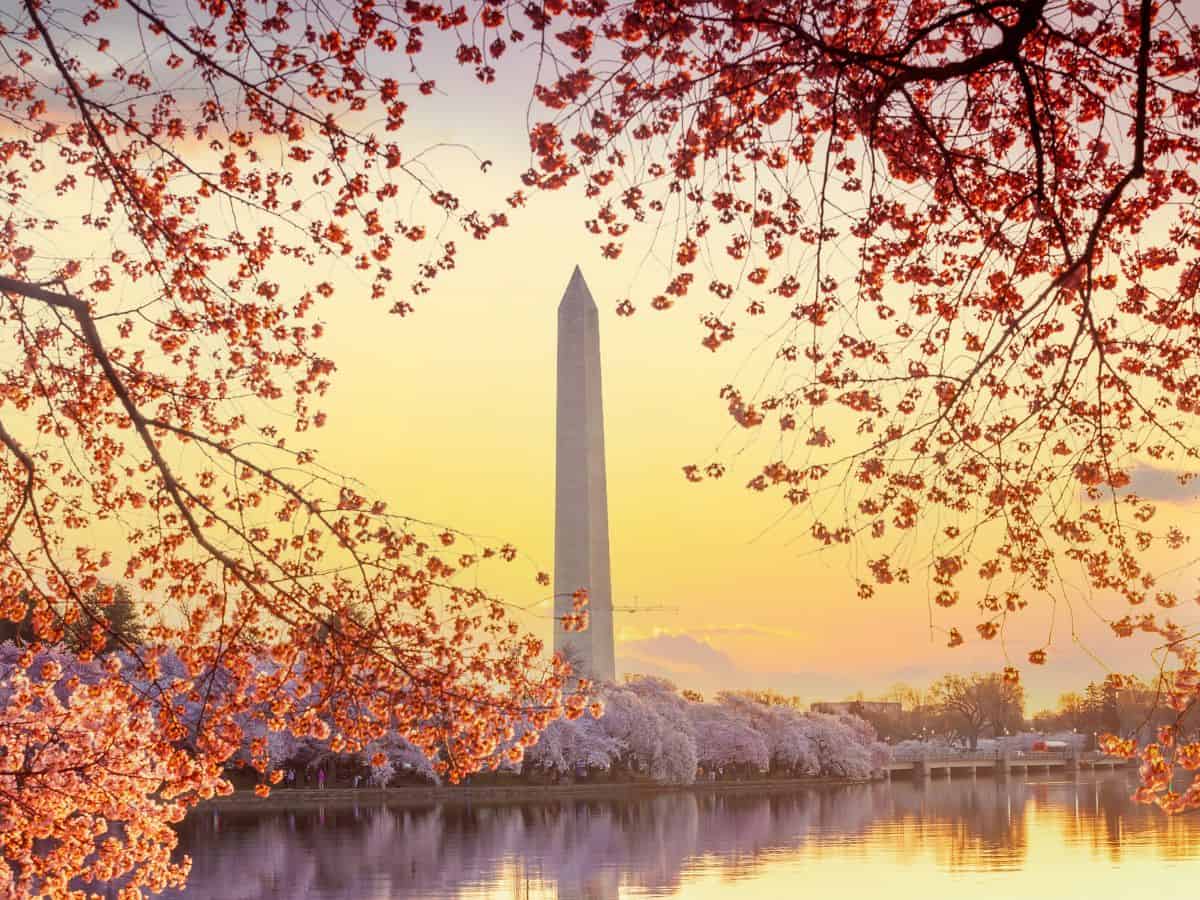





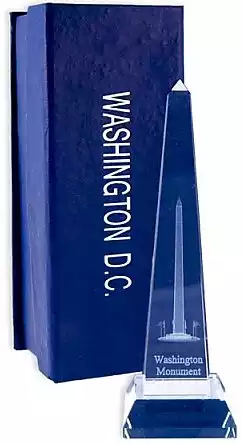
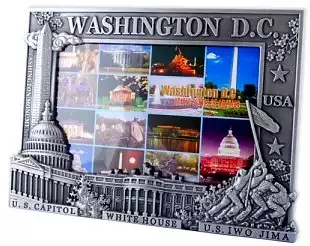



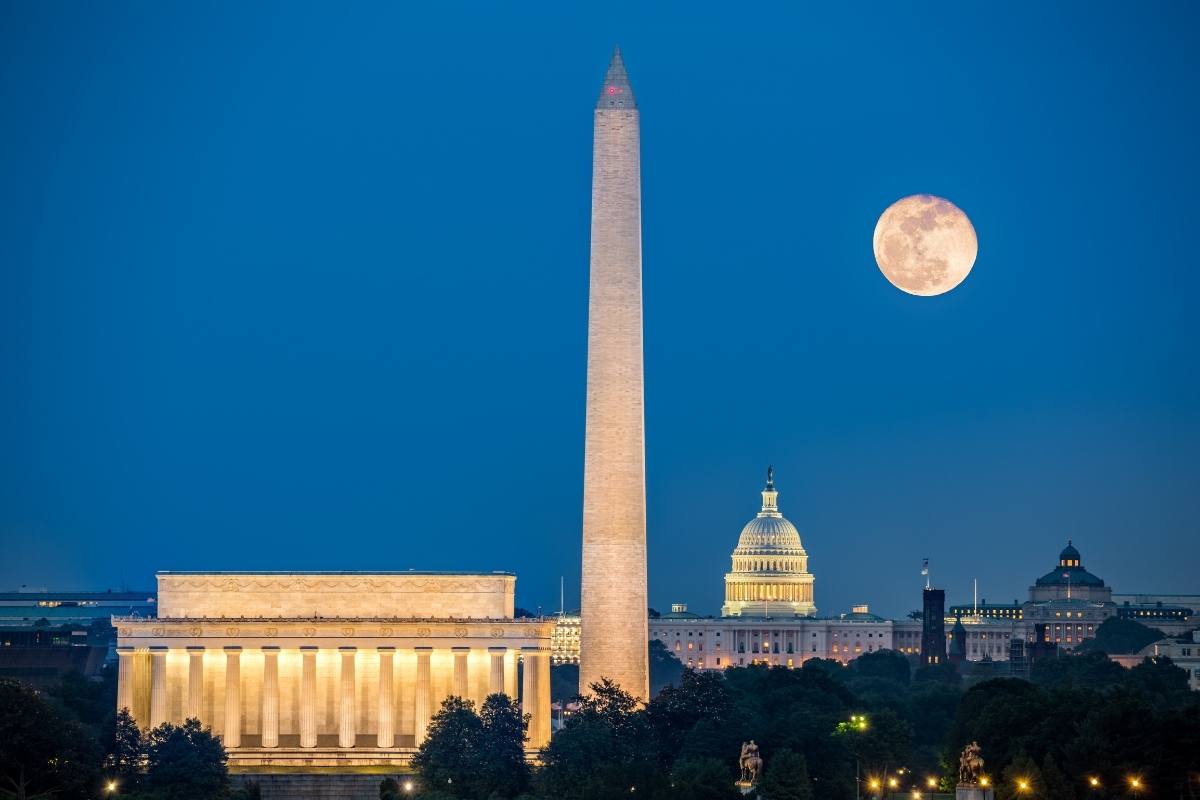

These are really interesting facts about the Washington Monument. It fascinates me to think that every structure in the world has its own unique history. I wonder if the Washington Monument can talk and speak, aside from the facts that you’ve mentioned, what would be the other facts that it would tell? I bet it is mind blowing! 🙂